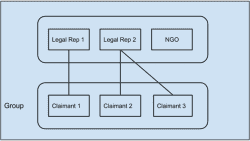How do I manage group conflicts?
A PIL case may be brought by one person or one organisation, or by a group of individuals and/or organisations. If you are thinking of bringing your case together with others, there are a number of things that you need to think about carefully.
Working together: things to think about
These are the questions you need to ask.
Q. Does everyone in your group have the right to bring the case?
There are situations in which only organisations and not individual persons will be able to bring a case. For example, it may be hard for one or two disabled persons to bring a case on behalf of disabled people in general, but it may be possible for an organisation of disabled people to do so.
Q. Does everyone in the group have compatible objectives and interests?
If some members of the group want to fight the case to the end for reasons of principle, and others just want compensation and will accept a payment to end the case without a ruling, this may create problems down the line.
Q. Can everyone in the group make the necessary commitment?
Will everyone be able to commit the necessary financial and time resources to the case for its full duration?
Q. Is everyone in the group willing to take the necessary risks?
Will they be able to deal with counter-attacks by the party against which the case is being brought? Risk appetite may depend a lot on the financial circumstances, constituency, and vulnerability of each member of the group.
Bringing a legal case with others is usually a major commitment which means working closely together over a long period of time.
It also often means taking risks together. It is therefore crucial that the members of the group know each other well enough and that there is a high level of trust among them.
Ground Rules for cooperation
The ground rules for cooperation among the members of the group bringing the case should be agreed clearly beforehand. The rules should cover issues such as:
- Who chairs the group and how are decisions taken?
- How are costs shared and who will administer the money and do the financial paperwork?
- How does communication within the group work?
- How does the group’s external communication with the media and the public about the case work?
- How does communication with the lawyer(s) and representative(s) arguing the case work? Who gives the instructions?
- How does communication with the opponent in the case work? Is it done only through the lawyer(s) or representatives arguing the case, or also by members of the group? If so, by which ones?
- What are the lawyers and representatives arguing the case allowed to share with each other and say to the media?
- How far does the group want to go? Will it accept an offer to settle the case, or does it want to fight the case to the end? Will it use all the available appeals? If the case is lost and the court orders the group to pay for the opponent’s legal costs, how will these costs be shared within the group? Will this sharing apply even if the court order mentions a different division of the costs?
- How will the group store sensitive information, such as its draft legal arguments, strategy documents, evidence containing sensitive personal information and so on? How will the group keep itself safe from attacks, if that is a risk?
- Link info: “How do I protect my confidential information?”
Tensions within the group
If there are multiple lawyers and representatives arguing the case, group dynamics can become quite complicated. It is important to think about the implications beforehand.
An illustrative case study
The following fictional case study illustrates what can go wrong.
Imagine that a gold mine is causing pollution of a river. Local farmers are unable to use the water to irrigate their land. Fishermen are unable to fish. The local village is unable to get clean water from its wells, which have been polluted too.
The local village council (Claimant 1), a fisherman (Claimant 2), a farmer (Claimant 3) and a non-governmental organisation (NGO) working for a clean environment decide to bring a case together against the mine.
Claimant 1 hires a lawyer (legal representative); Claimants 2 and 3 decide to split the costs and hire a second lawyer; and the NGO has a lawyer on staff who can represent its interests. See the chart below.

Some examples of tensions that could arise in this group are:
- The mine offers to supply clean water to the town from a neighbouring region and to pay generous compensation for the period that the wells couldn’t be used, on condition that the case is withdrawn. The mine doesn’t plan to do anything about the pollution of the river. It could be that Claimant 1 wants to accept this offer but Claimants 2 and 3 and the NGO do not.
- Claimants 2 and 3 feel that Legal Representative 1, the lawyer for Claimant 1, isn’t representing the interests of the group properly and start sending instructions to him/her. However, Legal Rep 1 says that he only accepts instructions from Claimant 1.
- Claimant 3 gets into financial difficulties and asks Claimant 2 to pay a bigger share of the legal bills, but Claimant 2 disagrees.
- The NGO publishes a statement saying that it wants the river to become a nature reserve, free from pollution and fishing. Claimant 2, the fisherman, is upset.
- The Claimants agree that they need an expert on water pollution to come to the trial as an expert witness, and Claimant 1 promises to arrange this, but Claimant 1’s lawyer misses the deadline to notify the court about this witness.
- The court rules that only Claimant 1 and Claimant 3 have the right to bring the case.
Who are we?
Action4Justice is a group of NGO's united to support public interest litigation worldwide as a means to advance social justice.
Learn moreOur members
- Oxfam
- PILAC
- Greenpeace
- Transparency International
- IHRDA
- FOREST PEO
- Forest People’s Programme
Support Us
We seek partnerships with organizations and communities worldwide who support our goals. Join our network, or volunteer.
Learn more
